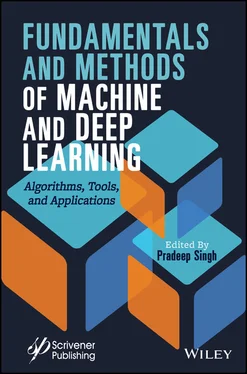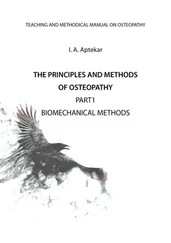Pradeep Singh - Fundamentals and Methods of Machine and Deep Learning
Здесь есть возможность читать онлайн «Pradeep Singh - Fundamentals and Methods of Machine and Deep Learning» — ознакомительный отрывок электронной книги совершенно бесплатно, а после прочтения отрывка купить полную версию. В некоторых случаях можно слушать аудио, скачать через торрент в формате fb2 и присутствует краткое содержание. Жанр: unrecognised, на английском языке. Описание произведения, (предисловие) а так же отзывы посетителей доступны на портале библиотеки ЛибКат.
- Название:Fundamentals and Methods of Machine and Deep Learning
- Автор:
- Жанр:
- Год:неизвестен
- ISBN:нет данных
- Рейтинг книги:5 / 5. Голосов: 1
-
Избранное:Добавить в избранное
- Отзывы:
-
Ваша оценка:
- 100
- 1
- 2
- 3
- 4
- 5
Fundamentals and Methods of Machine and Deep Learning: краткое содержание, описание и аннотация
Предлагаем к чтению аннотацию, описание, краткое содержание или предисловие (зависит от того, что написал сам автор книги «Fundamentals and Methods of Machine and Deep Learning»). Если вы не нашли необходимую информацию о книге — напишите в комментариях, мы постараемся отыскать её.
The book provides a practical approach by explaining the concepts of machine learning and deep learning algorithms, evaluation of methodology advances, and algorithm demonstrations with applications.
Audience
Fundamentals and Methods of Machine and Deep Learning — читать онлайн ознакомительный отрывок
Ниже представлен текст книги, разбитый по страницам. Система сохранения места последней прочитанной страницы, позволяет с удобством читать онлайн бесплатно книгу «Fundamentals and Methods of Machine and Deep Learning», без необходимости каждый раз заново искать на чём Вы остановились. Поставьте закладку, и сможете в любой момент перейти на страницу, на которой закончили чтение.
Интервал:
Закладка:
1.8.8 Online Video Streaming (Netflix)
More than a 100 million users use Netflix, and there is no doubt that it is the most-streamed web service in the whole world. Netflix application use ML algorithms which collect a massive amount of data about the users, when the user pauses, rewinds, or fast forwards. It also takes data depending on the day you watch the content, the date and time, and mainly the rating pattern and search pattern. The application collects these data from each of their users they have and use their recommendation systems and a lot of algorithms related to ML approaches.
1.8.9 Fraud Detection
Currently, online credit card fraud detection is 32 billion dollars market in 2020. That is approximately higher than the profit made by many MNC companies combined. Nowadays, the number of payment channels like a credit card, debit card, numerous wallets, UPI, and much more has increased the number of criminals. ML approaches fraud detection as a classification problem.
1.9 Conclusion
In the anticipating years, ML will embrace a significant reason in the divulgence of data from the abundance of information that is at present open in a different zone of utilization. The supervised learning strategies are developing constantly by the information researchers, which contain an enormous arrangement of algorithms. This zone has the consideration of numerous engineers and has picked up generous advancement in the most recent decade. The learning strategies accomplish magnificent execution that would have been hard to get in the earlier many years. Given the reckless development, there is a lot of room for the engineers to work effectively and to develop the SML strategies.
References
1. Iqbal, M. and Yan, Z., Supervised Machine Learning Approaches: A Survey. Int. J. Soft Comput ., 5, 946–952, 2015, 10.21917/ijsc.2015.0133.
2. Nasteski, V., An overview of the supervised machine learning methods. Horizons. B ., 4, 51–62, 2017, 10.20544/HORIZONS.B.04.1.17.P05.
3. Sharma, R., Sharma, K., Khanna, A., Study of Supervised Learning and Unsupervised Learning. Int. J. Res. Appl. Sci. Eng. Technol. (IJRASET) , 8, VI, June 2020.
4. Kotsiantis, S.B., Supervised Machine Learning: A Review of Classification Techniques, in: Proceedings of the 2007 conference on Emerging Artificial Intelligence Applications in Computer Engineering: Real Word AI Systems with Applications in eHealth , HCI, Information Retrieval and Pervasive Technologies, The Netherlands, 2007.
5. Osisanwo, F.Y., Akinsola, J.E.T., Awodele, O., Hinmikaiye, J.O., Olakanmi, O., Akinjobi, J., Supervised Machine Learning Algorithms: Classification and Comparison. Int. J. Comput. Trends Technol. (IJCTT) , 48, 3, 128–138, June 2017.
6. Brownlee, J., Linear Regression for Machine Learning – Machine Learning Mastery, [online] Machine Learning Mastery https://machinelearningmastery.com/linear-regression-for-machine-learning/.
7. Brownlee, J., Logistic Regression for Machine Learning – Machine Learning Mastery, [online] Machine Learning Mastery Available at: https://machine-learningmastery.com/logistic-regression-for-machine-learning/.
8. Mitchell, T., Machine Learning , 432pp., McGraw Hill, Carnegie Mellon University, 2015.
9. https://www.javatpoint.com/machine-learning
10. https://www.tutorialspoint.com/machine_learning_with_python/classification_algorithms_support_vector_machine.htm
11. https://www.edureka.co/blog/supervised-learning/
12. https://machinelearningmastery.com/supervised-and-unsupervised-machine-learning-algorithms/
13. Fabris, F., Magalhães, J.P., Freitas, A.A., A review of supervised machine learning applied to ageing research. Biogerontology , 18, 2, 171–188, 2017.
14. Ayodele, T., Types of Machine Learning Algorithms, InTech Open, 2010, https://www.intechopen.com/chapters/10694
15. Musumeci, F. et al ., An Overview on Application of Machine Learning Techniques in Optical Networks. IEEE Commun. Surv. Tutorials , 21, 2, 1383– 1408, Secondquarter 2019.
16. https://en.wikipedia.org/wiki/Logistic_regression
17. https://www.edureka.co/blog/decision-trees/
18. Mohri, M., Rostamizadeh, A., Talwalker, A., Foundations of machine learning , MIT Press, Cambridge, MA, 2012.
19. Cioffi, R., Travaglioni, M., Piscitelli, G., Petrillo, A., De Felice, F., Artificial Intelligence and Machine Learning Applications in Smart Production: Progress, Trends, and Directions. Sustainability , 12, 492, 2020.
20. Behera, R. and Das, K., A Survey on Machine Learning: Concept, Algorithms and Applications. Int. J. Innov. Res. Comput. Commun. Eng ., 5, 2, 1301–1309, 2017.
21. Domingos, P., A few useful things to know about machine learning. Commun. ACM , 55, 10, 14–20, 2012.
1 * Corresponding author: shruthihshetty02@gmail.com
2 † Corresponding author: sumikshashetty7@gmail.com
3 ‡ Corresponding author: chandrasingh146@gmail.com
4 § Corresponding author: ashu1280@gmail.com
2
Zonotic Diseases Detection Using Ensemble Machine Learning Algorithms
Bhargavi K.
Department of Computer Science and Engineering, Siddaganga Institute of Technology, Tumakuru, India
Abstract
Zonotic diseases are a kind of infectious disease which spreads from animals to humans; the disease usually spreads from infectious agents like virus, prion and bacteria. The identification and controlling the spread of zonotic disease is challenging due to several issues which includes no proper symptoms, signs of zoonoses are very similar, improper vaccination of animals, and poor knowledge among people about animal health. Ensemble machine learning uses multiple machine learning algorithms, to arrive at better performance, compared to individual/stand-alone machine learning algorithms. Some of the potential ensemble learning algorithms like Bayes optimal classifier, bootstrap aggregating (bagging), boosting, Bayesian model averaging, Bayesian model combination, bucket of models, and stacking are helpful in identifying zonotic diseases. Hence, in this chapter, the application of potential ensemble machine learning algorithms in identifying zonotic diseases is discussed with their architecture, advantages, and applications. The efficiency achieved by the considered ensemble machine learning techniques is compared toward the performance metrics, i.e., throughput, execution time, response time, error rate, and learning rate. From the analysis, it is observed that the efficiency achieved by Bayesian model combination, stacking, and Bayesian model combination are high in identifying of the zonotic diseases.
Keywords :Zonotic disease, ensemble machine learning, Bayes optimal classifier, bagging, boosting, Bayesian model averaging, Bayesian model combination, stacking
2.1 Introduction
Zonotic diseases are a kind of infectious disease which spreads from animals to human beings; the disease usually spreads from infectious agents like virus, prion, virus, and bacteria. The human being who gets affected first will, in turn, spread that disease to other human beings likewise the chain of disease builds. The zonotic disease gets transferred in two different mode of transmission, one is direct transmission in which disease get transferred from animal to human being, and the other is intermediate transmission in which the disease get transferred via intermediate species that carry the disease pathogen. The emergence of zonotic diseases usually happens in large regional, global, political, economic, national, and social forces levels. There are eight most common zonotic diseases which spread from animal to humans on a wider geographical area which include zonotic influenza, salmonellosis, West Nile virus, plague, corona viruses, rabies, brucellosis, and lyme disease. Early identification of such infectious disease is very much necessary which can be done using ensemble machine learning techniques [1, 2].
Читать дальшеИнтервал:
Закладка:
Похожие книги на «Fundamentals and Methods of Machine and Deep Learning»
Представляем Вашему вниманию похожие книги на «Fundamentals and Methods of Machine and Deep Learning» списком для выбора. Мы отобрали схожую по названию и смыслу литературу в надежде предоставить читателям больше вариантов отыскать новые, интересные, ещё непрочитанные произведения.
Обсуждение, отзывы о книге «Fundamentals and Methods of Machine and Deep Learning» и просто собственные мнения читателей. Оставьте ваши комментарии, напишите, что Вы думаете о произведении, его смысле или главных героях. Укажите что конкретно понравилось, а что нет, и почему Вы так считаете.












